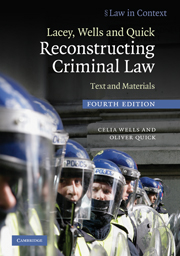Book contents
- Frontmatter
- Contents
- Preface
- Table of cases
- Table of statutes
- Section I Approaching Criminal Law
- Section II Law, Order and Security
- Section III Interpersonal Violence; Drugs and Alcohol Abuse; Offence Preparation and Participation
- Section IV Property and Propriety
- Section V Regulating Sexuality and Bodily autonomy
- Section VI Making a Killing
- Bibliography
- Index
Section V - Regulating Sexuality and Bodily autonomy
A Crisis of Trust and Intimacy?
Published online by Cambridge University Press: 05 June 2012
- Frontmatter
- Contents
- Preface
- Table of cases
- Table of statutes
- Section I Approaching Criminal Law
- Section II Law, Order and Security
- Section III Interpersonal Violence; Drugs and Alcohol Abuse; Offence Preparation and Participation
- Section IV Property and Propriety
- Section V Regulating Sexuality and Bodily autonomy
- Section VI Making a Killing
- Bibliography
- Index
Summary
The categorisation of many of the issues dealt with in this section presents difficult decisions. Should rape, sexual assault and the sexual transmission of disease be thought of not as specifically sexual offences but as crimes of violence, and hence included in Section VI? Clearly, the latter offences may be regarded as involving violence, though they are equally clearly connected with cultural images of male and female sexuality and of bodily autonomy, which we begin to unpack in Chapter 14. The nonconsensual element of rape and many forms of sexual assault might be thought to separate them, in turn, from regulation of areas such as prostitution and pornography, which have symbolic and public order dimensions. We have located these issues side by side in Chapters 15 and 16 because each of them raises issues about bodily autonomy and, in particular, about consent and the conditions under which consent can be said to be ‘valid’. Consent becomes a key concept when we look at the extent to which the state regulates our autonomy. Can we choose to exercise control over our bodies, even to the extent of choosing to die? In Chapter 17 we look at the criminalisation of healthcare choices, both at the beginning and end of life. The regulation of reproduction contributes to the construction of sexuality as well as limiting bodily autonomy more generally. Contraception and abortion are not the only relevant issues. Criminal laws are invoked to prohibit the commercialisation of surrogacy arrangements.
- Type
- Chapter
- Information
- Lacey, Wells and Quick Reconstructing Criminal LawText and Materials, pp. 473 - 476Publisher: Cambridge University PressPrint publication year: 2010



